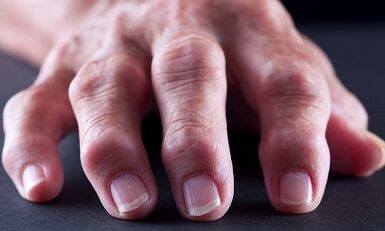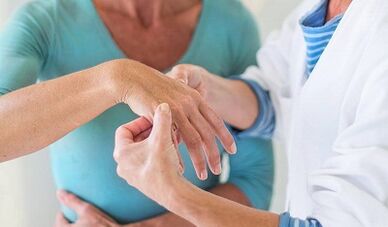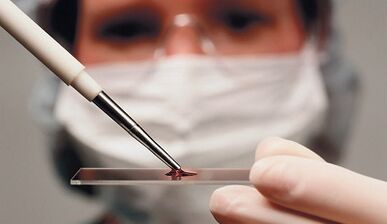Arthritis and arthritis are diseases in which the joints are affected.Since the name of these diseases is consonant, many people have thoughts about their identity.These terms are considered synonyms, which suggests that this is the same disease.However, arthrosis and arthritis are far from the same and there is a significant difference.To understand how arthrosis is different, let us find out what these diseases are.
What is arthritis?
Arthritis is a collective expression that means that any joint is ignited and most often indicate wider and severe abnormal disorders in the body.That is, the disease is inflammatory and can impress both one and multiple joints.
There are many diseases accompanied by the development of arthritis:
- rheumatism;
- gout;
- rheumatoid arthritis;
- systemic lupus erythematosus;
- psoriasis;
- Hemhramatosis.
In addition, there are reactive arthritis that results
- flu;
- syphilis;
- gonorrea;
- mycoplasmosis;
- Chlamydia.
All these diseases are released in a separate group.
The inflammatory processes of arthritis primarily affect synovial shell and synovial fluid and cause disease (synovitis).As a result, the amount of this fluid increases, which is interpreted by swelling of the affected joints.The cartilage covering the surface of the bones also inflains and, over time, which expresses the bone, it develops on it.
What is arthrosis?

Arthrosis is a non -inflammatory dystrophic disease that involves deformation and destruction of cartilage tissue in the joint.That is, pathological changes occur, which are manifested by the dystrophy of the cartilage that lined the surfaces of the bones.Although sometimes it is a long -term inflammatory process that triggers the thinning and damage of the cartilage.Arthrosis is often observed in the elderly as they wear age cartilage tissue and there is also osteoporosis, which has a negative impact on the condition of the complete support and motor device.
In some cases, arthrosis can occur in people who have a long load on the joints.This category includes athletes, people with obesity or people whose professional activities lead to the rapid wear of the supporter and motor system.
The symptoms of the disease are caused by violation of the function of the cartilage, as they become thinner and deformed, the bone tissue increases, leading to the inability to complete and friction of the joint bones.As a result, the amount of synovial fluid, which should be seized with joint surfaces.
The general causes of the formation of arthritis and arthritis
Because arthritis and arthritis affect the joints, and usually the complete support engine of the motor device, these diseases are as a result of many factors.
Let's look at ten reasons that cause these diseases:
- hereditary factor;
- metabolic violation;
- immune factor (especially in arthritis);
- Congenital diseases of bond and bone tissue;
- joint injuries;
- overweight, obesity;
- excessive physical activity;
- unbalanced diet;
- hypothermia;
- Infections.
These are general causes that can cause both joint inflammation and arthrosis.But here their similarity ends.In addition, diseases have only differences.
Characteristic causes of arthritis and arthrosis
Caused by arthritis:

- An unbalanced monotonic diet that violates metabolism and immunity (malnutrition provokes infectious diseases and their agents penetrate the synovial fluid and cause arthritis);
- The joint is strong hypothermia (bathing in the tent, in cold water overnight, poor poor quality shoes and clothes);
- any injury (stretching, bruising or fracture);
- smoking and obesity;
- Sitting lifestyle.
The joint reasons:
- hereditary factor;
- elderly;
- injuries;
- Metabolic diseases.
Previously, the primary (when the cause of the disease was unknown) and secondary (when the cause was known) is the stage of the development of arthrosis.With the development of more advanced diagnostic methods, the primary stage has been questioned, since the development of arthrosis is always metabolism in the form of carbohydrate metabolism and iron enzymes.Therefore, arthrosis can occur as a result of arthritis, since synovial fluid dystrophy is nothing more than a metabolic disorder.In the dyspropic processes, the circulation of the joint, which leads to deterioration of nutrition and the destruction of the cartilage.
What is the difference between arthrosis between arthrosis
Let's look at how arthrosis is different.Because arthritis and arthrosis often affect the same joints, there is still some patterns in the localization of the pathological process:
- Arthrosis is often formed on the large joints of the lower limbs (ankles, knees, hips).In addition, the pathological process develops only in one joint.Throughout life, these joints have very heavy loads, so it is not surprising that they are worn out and destroyed due to the devastating processes.Rarely arthrosis affects the joints between the thumb, hands and vertebrae.
- In the case of arthritis, the joints are touched individually, ie the disease is typical of "flight".Suppose the wrist joint was inflamed in one day and in the other - the third - the shoulder joint was inflamed.In addition, many asymmetric joints may be ignited at the same time.
Apart from the characteristic localization of the pathological process, there is a difference between arthritis and arthrosis between symptoms:
- In the case of arthritis, pain occurs at night when a person is at rest.And in the morning, patients feel characteristic stiffness in the affected joints.They need to develop the joints to relieve stiffness.Some patients interpret these phenomena as norms, forgetting that healthy people do not need joint development after sleeping.Their composition is always mobile and functional.In the case of arthrosis, such stiffness cannot be observed.
- In the case of arthrosis, everything is the other way around.At rest, the patient is relieved as the pain only intensifies with movement and significant motor activity.Occasionally, pain can occur in arthrosis, but they are associated with the fact that the patient changes the position of the affected limbs in a dream that causes pain.
- The appearance of arthritis and arthritis is also different.In the case of arthritis, the metacarpal phalanx joints (concentrated fist convex bones) swell and swell, blush and heat (the local temperature rises).In the case of arthrosis, such symptoms cannot be observed and the joint seems completely normal.Of course, in the future, joint deformation may occur in the growth of osteophytes (bone growth in the joints), but even in this case, it is not the symptoms of arthritis.However, in the case of arthrosis, crunch is observed in the affected joint, which is not arthritis.
The general condition of the patients should be noted in these diseases.In the case of arthritis, one person feels weakness in addition to arthritis, and feels a general disease: sub -white temperature, chills, headache, loss of appetite, reduced body weight.In the case of arthrosis, the problem is only in a functional and painful joint and the general symptoms are not observed.
It should be noted that arthritis often leads to arthritis when the joint is destroyed and modified as a result of inflammation and its mobility is disturbed.However, in the case of arthrosis, inflammatory processes are observed in the joints.It is not that easy to understand the diagnosis, you need to know the cause of these diseases.Arthritis usually occurs due to injury in the background of infections that enter the arthritis and, in the case of arthrosis, due to injury.Of course, inflammation can sometimes be connected, but it doesn't always happen.
Differential diagnosis of arthritis and arthritis
To find out why there were problems with the joint, it is necessary to perform differential diagnosis.This diagnosis includes the following clinical tests:
- General blood test.
- General urine analysis;
- Biochemical blood test;
- rheumatic tests;
- autoimmune norms (blood tests of antibodies);
- X -grave of the affected joints;
- Examination of synovial fluid;
- Radioisotopic scanning of the skeleton (in some cases);
- Computer tomography (CT);
- Magnetic - resonance tomography (CT or MRI).
Blood tests of arthritis and arthritis
This procedure is mandatory and necessary to properly diagnose joint diseases.In the case of arthrosis, the clinical image of the blood does not change at all, but only slightly increases the ROE (reaction of the erythrocyte settlement) to 28-30 mm, usually with complication synovitis.In the case of arthritis, the blood count changes completely: the leukocytes increase to 14,000, the leukocyte formula to the left, the C -reactive protein (CRB) and the ROE increase to 40-80 mm.
C - jet in the blood

Biochemical blood tests should be performed for differential diagnosis.In the case of arthritis, certain immunoglobulins, seromucoid and reactive protein C, which is not observed in arthrosis, increases.In arthritis, the exact factor in the level of the inflammatory process is considered to be C - Reactive Protein (CRB).As the synovial fluid responds to protein to the emerging inflammation, its level of inflammatory and autoimmune in the body increases to 10 mg/l.Compared to healthy people with a reactive protein in the blood does not exceed 0.002 g/l.Thus, the increased levels of reactive protein in blood plasma eloquently indicate the development of arthritis.
C - Reactive Protein (CRB) is a fast -phase protein that is synthesized in the liver.Activates the body's immune response to invasion of the inflammatory factor.After 24 hours, the level of reactive protein in the plasma increases ten times.With proper treatment, the protein is quickly reduced to normal indicators.Reactive protein indicators are still normal with the patient's blood arthrosis.
X -tumor of the affected joints
This is the diagnostic method after the second most effective clinical blood test.In this case, arthrosis is accurately diagnosed because the degree of deformation of the bone can be determined by the width of the joint gap on the X -ray.In the case of arthritis, this method is not significant, although it is certainly prescribed as diagnostic techniques.However, this method is imperfect because the degree of damage and destruction of cartilage tissue is not visible in the picture.
Differences in the treatment of arthritis and arthrosis
There are different causes and mechanisms of development of arthritis and arthrosis, so their treatment is slightly different.
In the case of arthritis, first and foremost, the cause of inflammation and should be neutralized as soon as possible.If there is an infectious etiology of arthritis, the patient is prescribed by antibiotics.The autoimmune origin of the disease prescribes cytostatics and hormones and requires urethric acid correction in the body for gouty arthritis, so treatment should be performed with hypoweminizing drugs.
In the case of arthrosis, the purpose of the treatment is to restore cartilage tissue and return joint functions.Therefore, treatment is performed by chondroprotectors, hyaluronic acid, physiotherapy, health crackling, massage and physiotherapy exercises.

Since both arthritis and arthrosis are accompanied by a pronounced pain syndrome, non -seertoidal anti -inflammatory drugs (tablets and ointments) act as an analgesic with these diseases.Such drugs not only effectively eliminate pain, but also reduce signs of inflammation.
Both conservative treatment and surgical therapy are used in the treatment of these diseases.It all depends on the level and scale of joint lesions.As a general rule, this is the drug treatment and prosthetics.
As the fact of the patient's chronic arthritis and arthrosis increases the likelihood of acute relapse, the therapeutic strategy should be directed to prevent and prevent relapse.The following treatment is prescribed for this:
- The use of non -steroid anti -inflammatory drugs (NSAIDs).The drugs of this group effectively eliminate the symptoms of inflammation, especially in the case of arthritis, but are always involved in the therapeutic complex and arthrosis.
- Rapid elimination of muscle spasm, which occurs in the muscles next to the joint.This provides access to drugs, nutrients and oxygen.
- Normalization of metabolic reactions.This is only possible after stopping the inflammatory process.
- Evacuation from the joint of the uric acid salts (when it comes to violation of metabolism).
- Normalization of acid - alkaline metabolism.
Modern medicine has succeeded in treating arthritis and arthrosis, but not all cases of arthritis or arthrosis end with full success.
The success of treating these diseases is to alleviate the inflammation of the arthritis and muscle cramps in the normalization of metabolic processes and acid -alkaline balance.As a result of these promotions, the joint is complete nutrition, oxygen and restore the metabolism process.
Recipes for traditional medicine are very effective in the treatment of arthritis and arthrosis.Use in this format is also approved by official medicine.It should be noted immediately that herbs are only a complementary drug to fight diseases.Therefore, it should not be requested to the attending physician before continuing with folk medicines.
Meal arthritis and arthritis
All joints in the joints require special dietary nutrition.Because the symptoms of arthritis affect the entire body, in some cases, severe disorders of the heart, kidneys and liver are complicated, and arthrosis can immobilize the patient, lead to disability, and thus reduce the quality of life, all the strength to overcome these diseases.

In the context of joint pathologies, the body should obtain all the nutrients, vitamins and minerals necessary with some distortion.The normalization of metabolic reactions and acid -alkaline balance is spent on products.
The general nutritional recommendations may be as follows:
- limits the consumption of red meat (pork, beef, lamb, deer, horses);
- rejection of large quantities of fat and trans fat products;
- complete rejection of alcohol;
- Enter low fatty fish and seafood;
- consumes a large number of vegetables, fruits and herbs (in any form);
- Consumption of food based on cartilage: flood, gel, jelly, jam;
- abundant drinking system;
- Take the dietary supplements using calcium, vitamin A, and V.
General prevention of arthritis and arthrosis
In the treatment of arthritis and arthrosis, therapeutic strategy consists of preventing and preventing arthritis and downturn in arthrosis.After all, it is easier to warn the disease than to treat.Therefore, there are the same principles of preventing these diseases:
- Avoid hypothermia of the legs (leg joints).After all, this path is the most important thing when worsening of chronic diseases and infection with viral infections.
- Timely relief of chronic diseases (tonsillitis, sinusitis, bronchitis).
- Denying uncomfortable, senior shoes.Unknown shoes create an additional burden on the joints, leading to destruction, deformation and dash, and arthrosis.
- Fighting overweight.Overweight is a sign of metabolic disorders, and arthritis is almost always due to such violations.
- Moderate physical activity.Heavy work exerts pressure and load on the joint, which results in destroyed and inflamed.
- Be sure to insist on a healthy lifestyle: often walk in the air, relax and eat, use physiotherapy exercises, and regularly visit a doctor.
Physical physical education in arthritis and arthrosis is a very important part of the therapy in the compartment of massage, diet treatment and physiotherapy.Provides painful joints with nutrients and oxygen, and without it, restoration and recovery cannot occur.


















































